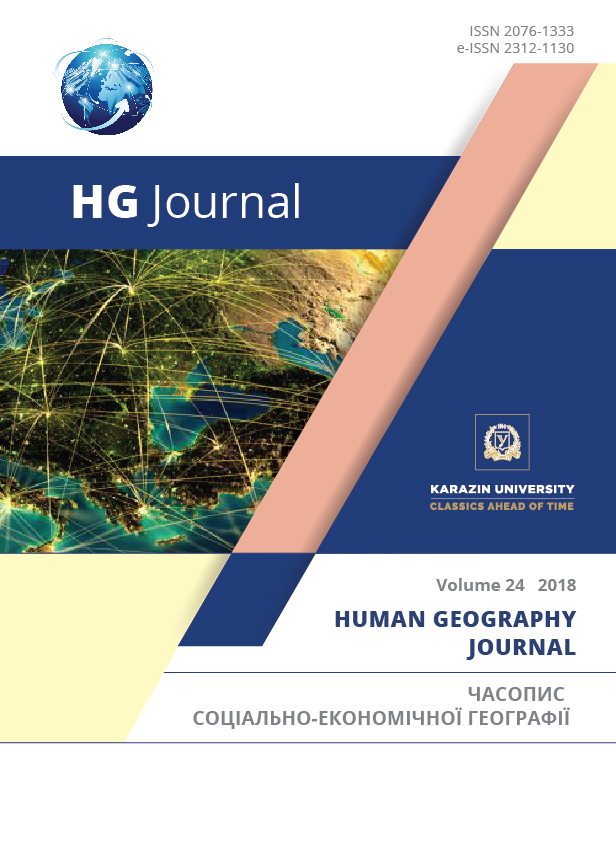Cultural landscap’s changes of Solyna commune
Abstract
The main aim of the present work was to analyze the dynamics of settlements from the 2nd half of the 18th century to 2nd half of 20th century in Solyna commune (in polish Solina), in Lesko district, Podkarpackie voivodeship in Eastern Poland. There was analyzed the Solyna commune in terms of the changes of settlements and applied maps together with published historical data for the analysis of changes in its structure. The first was the historical map, in other words the tactical map of «WIG- Military Institute of Geography». Next maps from the «WMS-Web Map Service, Geoportal» were analyzed. Changes in the number of villages and households population dynamics for Greek-catholics, «Latynnykys» and Jews for the year 1785 were evaluated applying ArcGIS 10.3 program. Ukrainian ones were evaluated using ArcGIS program in comparison with the number of Poles and Jews for the year 1939. Ethnic and religious composition from the 2nd half of the 18th century to 2nd half of 20th century and the character of settlements distribution in Solyna commune was evaluated based on the study of spatial distribution of settlements with the use of Spatial Statistics (Spatial Autocorrelation Global Moran's test, Standard Deviational Ellipse and Mean Centre). In 1785 there were 80,55% of Greek-catholics and in 1939 there were 89,82% of Ukrainians in Solyna commune. There was confirmed a similar configuration of Standard Deviation Ellipse and Mean Center for Greek-catholic for the year 1785 and Ukrainians for the year 1939 in Solyna commune. The scale and results of such changes are essential for future research, mainly in terms of the change of traditional village system infrastructure and culture.
Downloads
References
Pavlyuk, S.P. (1986). Narodna agrotekhnika ukraintsiv Karpat drugoi polovyny XIX – pochatku XX st. [National agro-tecnic of Ukrainians in Carpathians from second part ХІХ to begining of XX century], Kyiv: Naukova dumka, 171 [in Ukrainian].
Utrysko, M. (1984). Etnografichni doslidzhennya Boykivshсhyny mizh dvoma viynamy [Ethnographic research of Boikivshchyna between the two wars] LB (E), 2/40 (51), 1-15 [in Ukrainian].
Affek, A. (2011). Wartości krajobrazu opuszczonego przez ludność na przykładzie byłej Rusińskiej wsi Borysławka. Prace Komisji Krajobrazu Kulturowego, 15, 148-160 [in Polish].
Agnoletti, M. (2006). The Conservation of Cultural Landscapes. CAB International, Wall-ingford and New York, 267 [in English].
Ambrozy, S., Wika S. (1998). Kierunki sukcesji zbiorowisk roślinnych z olszą szarą Alnus incana (L) Moench na grun-tach porolnych w Bieszczadach Zachodnich. Prace instytutu badawczego leśnictwa. Seria A, 855, 104-142 [in Polish].
Antrop, M. (2005). Why landscapes of the past are important for the future. Landscape Urban Plann, 70, 21-34 [in English].
Augustyn, B. (2016). Pozostałości dawnej zabudowy wsi. Bojkowszczyzna Zachodnia – wczoraj, dziś i jutro. Redaktor Jacek Wolski. Warszawa, 2, 65-85 [in Polish].
Blażejowskyj, D. (1995). Historical Šematism of the Eparchy of Peremyśl'. Lviv: Kameniar, 1008 [in Polish].
Budzyński, Z. (1993). Ludnośc pogranicza Polsko-Ruskiego w drugiej Polowie 18 wieku. Przemyśl – Rzeszów, 489. [in Polish].
Еlbakidze, M. Angelstam, P. (2007). Implementing sustainable forest management in Ukraine´s Carpathian mountains: the role of traditional village systems. Forest Ecology and Management, 249/1, 28-38. [in English].
European Landscape Convention (2000). European Treaty, Council of Europe, 176, 7 [in English].
Holly, G. (2014). Stosunki wyznaniowe i narodowościowe na pograniczu polsko-słowacko-ukraińskim. Roczniki Bieszczadzkie, 15, 179-207 [in Polish].
Iwanusiw, O. (1987). Church in Ruins: The demise of Ukrainian churches in the eparchy of Peremyshl. St. Catharines: St. Sophia, 354 [in English].
Kubijovyč, V. (1983). Ethnic groups of the South-Western Ukraine (Galyčyna-Galicia) 1.1.1939. München: Logos, 217 [in English].
Luboński, P. (2015). Przewodnik Bieszczady. Boсz, 268 [in Polish].
Mapire second (1763). Retrieved from http://mapire.eu/en/map/secondsurvey [in English].
Stan i struktura ludności (2011). Baza Demograficzna. Retrieved from http://demografia.stat.gov.pl/bazademografia/ [in Polish].
Skorowidz Map. 1:100 000. Retrieved from http://igrek.amzp.pl/mapindex.php?cat=WIG100 [in Polish].
Stępień, A., Kozak, I., Kozak, H. (2011). Trójwymiarowa rekonstrukcja obiektu architektoniczno-krajobrazowego na przykładzie nieistniejącej cerkwi w Bieniowej (Bieszczady Zachodnie). Roczniki Bieszczadzkie, 19, 379-387 [in Polish].
Rastrowa Mapa Topograficzna Polski (1965). Retrieved from http://www.geoportal.gov.pl/uslugi/usluga-przegladania-wms [in Polish].
UNESCO (1999). Evaluations of cultural properties. International Council on Monuments and Sites (ICO-MOS). UNESCO, WHC-99/CONF.209/INF.7. Marrakesh, Morocco, 188 [in English].
Urbański, J. (2010). GIS w badaniach przyrodniczych. Gdańsk: Wydawnictwo Uniwersytetu Gdańskiego, 266 [in Polish].
Wolski, J. (2007). Transformations of the high Bieszczady Mountains rural landscape during the last 150 years. War-szawa: IGiPZ PAN im. S. Leszczyckiego, 228 [in English].
Copyright (c) 2018 Козак І., Козак Г.

This work is licensed under a Creative Commons Attribution 4.0 International License.




